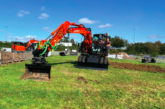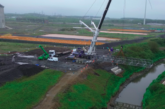A survey of 100 construction companies across the UK conducted by the MHA Association of accountancy firms reveals a stark divide in how construction companies have fared during the COVID-19 crisis.
While almost half of companies (49%) said the impact of COVID-19 has been substantial, over four in ten (44%) said it has had only minimal impact on their business. Only 5% stated the damage was critical. The division is also apparent in terms of expectations for the future. Almost a third (32%) said business activity was now back to normal, or nearly back to normal, while 30% believe it will take over a year to return to pre-pandemic levels.
The biggest concern, shared by 61% of respondents, is economic uncertainty. Supply chain disruption also ranked high on the list of worries, mentioned by 45% of respondents. Cash flow was cited as a concern by only 32% of companies surveyed. This reflects the fact that the industry entered 2020 with strong balance sheets, low debt risk and an increase in turnover of 8.3% from the previous year. In general, larger companies improved their cash flow situation prior to the pandemic to a great degree than smaller companies.
The overwhelming majority of respondents (81%) have made use of the furlough scheme and a large majority of these companies (71%) plan to bring all furloughed staff back. Close to a third (32%) have had to make redundancies.
Over two-thirds of companies surveyed (68%) have used the VAT deferral scheme. However, take up of other schemes was much lower, with only 13% making use of the Coronavirus Business Interruption Loan Scheme (CBILS) and 12% taking advantage of the Bounce Back loan scheme. Only 27% said it was very hard to access government funding, while 47% said it was very easy.
Commenting on the results of the survey, Robert Dowling, Head of Construction and Real Estate at MHA said: “The sector was in relatively good shape going into the pandemic. The striking divide between companies saying the impact of COVID-19 was minimal and those saying it was substantial is partly due to company size and cash flow position. By and large, bigger companies proved more effective in improving their financial position after the collapse of Carillion and this enabled them to better withstand the shock from COVID-19.
“The future however is very uncertain. Government projects are now the most likely source of revival for the sector; housebuilding, although currently buoyed up by strong demand is likely to suffer from a rise in unemployment and commercial building is unlikely to thrive, with many companies questioning whether they need as much office space as before.
“The fact that companies have had such different pandemic experiences means any future government relief must be properly targeted; not everyone needs help and there is no blanket solution for the companies that do need assistance. In particular the government needs to be mindful that big infrastructure projects tend to benefit larger companies the most, and even disadvantage small ones by sucking in materials and labour. The smaller players must not be neglected when it comes to new contracts especially as, broadly speaking, they have coped less well with the pandemic.”









